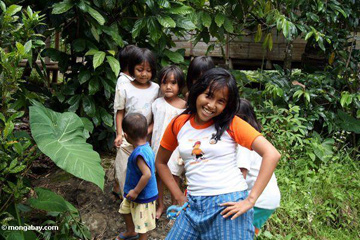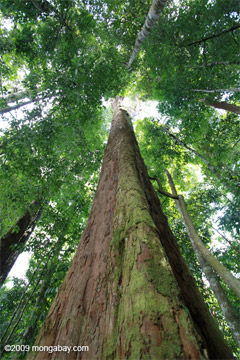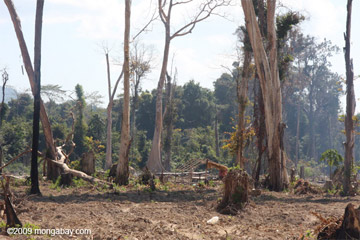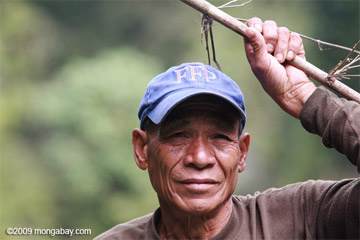As world leaders meet to thrash out the next incarnation of the Kyoto climate agreement, the world waits with baited breath to see how greenhouse gas emissions from forests might be included. Despite the high powered nature of these important global decisions, the success of REDD will ultimately be decided by humble forest dependent communities, living in developing countries and perhaps currently oblivious to the negotiations taking place. Dr Julie Fischer, Communities Specialist on Fauna & Flora International and Macquarie Capital’s Carbon Forests Taskforce, explains why REDD will fail unless it adequately accounts for, or indeed is steered by, these communities.
Less than a month away from the 15th Conference of the Parties for the UNFCCC, and serious debate continues on how a Reduced Emissions from Deforestation and Forest Degradation (REDD) mechanism could be incorporated into a 2012 climate change agreement.
Fauna & Flora International (FFI) believes REDD should compliment a broader set of climate change mitigation strategies, which does not diminish the global imperative to reduce fossil fuel consumption or to set strict emission reduction targets for Annex 1 countries. However, well-designed REDD activities can make an immediate and direct contribution to reducing carbon emissions, whilst delivering biodiversity conservation benefits, and enhancing sustainable development and rural livelihoods. As a practitioner focused on the rights and well-being of local communities under REDD, my role is to ensure that the opportunities and benefits of REDD for communities are realized, and that the risks in turn are minimized.

|
Many critics have expressed legitimate concerns about REDD in terms of equity, governance, forest access and tenure, Indigenous Peoples and local communities’ rights, and other critical social, economic and cultural issues. Meanwhile, natural forests in Indonesia, where FFI is pursuing a number of REDD initiatives, continue to be felled for conversion to palm oil, timber extraction, pulp and paper plantations, mining, food crop production and other uses.
As tropical forests are cleared in the face of a changing global climate, biodiversity is being lost at an alarming rate and forest dependent communities are growing increasingly more vulnerable as their resource base dwindles. Local inhabitants have few, if any, alternative livelihood strategies to pursue. These global and local realities motivated FFI to design REDD projects with a focus on getting it right on the ground; and we are bolstered in taking on this challenge by the successes we have had in addressing habitat protection by tackling local livelihood issues.
FFI maintains that by designing REDD projects focused on local, forest dependent communities, we will conserve the forest. Thus, we see the forest not only for the trees and the sequestered carbon but in a more holistic way – biodiversity, watershed conservation, sustainable forest management and the people who depend on the forest resources. Realizing the potential of REDD requires us to address many of the critics’ concerns head on. FFI is striving to do just that with its work under the FFI/Macquarie Carbon Forests Taskforce.
 Giant Dipterocarp tree in Sumatra |
Our approach and methodology aims to enhance historic rights to forest resources by addressing key equity and rights issues in the design and development of REDD projects in diverse settings. Early and active community involvement in decisions about roles, responsibilities and benefits build trust among stakeholders. Through careful and fully participatory project design and implementation, REDD can be a win-win-win situation for the global climate, forest dependent communities, and biodiversity.
All the areas FFI has identified for prospective REDD projects in West Kalimantan (Indonesian Borneo) are on the brink of being cleared for timber and conversion to palm oil or pulp and paper plantations. Forest dependent and Adat communities, some of whom have customary rights but no statutory rights to the forested land, have been hitherto unsuccessful in stopping the primary drivers of deforestation resulting in destroyed local livelihoods and eroding the socio-cultural base of these communities.
Developing robust and equitable methodologies and implementation approaches is complex, but a few broad principles guide our work; full stakeholder participation, a multi-tiered approach, a commitment to Free, Prior and Informed Consent (FPIC), a recognition of and focus on local resource use and management rights, equitable benefit sharing and the need for strong forest governance.
Participatory REDD project design and development.
|
Malagasy girl. Photo by Rhett A. Butler |
Communities living around and within the boundaries of forested land identified as a potential REDD site are central to the development, design and implementation of any project that might occur. Currently the FFI/Macquarie Taskforce is working with national and local non-governmental organizations (NGOs) to design REDD projects that are based on local input and priorities. Inclusion of local community members within the project design team significantly strengthens the likely success of our projects.
We are convinced that without full participation and leadership from local communities the proposed REDD sites will not remain forest for long. For this reason we are designing REDD projects with active participation from local stakeholders to assess the drivers of deforestation and develop strategies and interventions to reduce these threats. Their involvement helps provide alternative livelihoods and opportunities for income generation, collaborate on forest management planning and the design of transparent benefit-sharing mechanisms. Although it is too early to claim success, we are encouraged by the active debate and participation of local community members in the process.
A Multi-tiered Approach.
FFI takes an integrated approach to REDD project development, recognizing that any decision over a forest involves and affects multiple stakeholders. For example, in West Kalimantan we are assisting district and provincial governments in their spatial planning and budget exercises, recognizing that the future of forests are affected by broader land use decisions. We are also working with the palm oil industry to protect high conservation value forest as well as contributing to the national REDD policy dialogue in support of decentralized REDD governance, equitable benefit sharing, and community carbon rights.
Indigenous Peoples’ rights and Free, Prior and Informed Consent (FPIC).
FFI is working closely with several local NGO partners to respect local communities’ statutory and customary rights to forests and forest management in Indonesia under current laws and regulations. Close interaction with these organizations has provided us with valuable guidance and advice on REDD project design and a culturally appropriate FPIC process to ensure protection and respect of Indigenous People’s and community rights throughout the process.
Forest governance.
 Child in Laos |
Our proposed governance and management structure for each REDD project is to partner actively with the communities and local government around the forest to improve governance and management of the forest resources. Community representatives will sit at the table with other project proponents and have a decision-making role within the management structure established for each REDD site.
Any successful REDD project will ultimately be determined by successful forest management on the ground. Activities considered vital to maintain the carbon resource include fire control, law enforcement, capacity building of local forest managers and monitoring activities, along with activities that address key secondary drivers of deforestation, will be the shared responsibility of all project proponents.
Forest access and tenure security.
In many cases there is a convergence between the sites most at risk of destruction and those with unclear or disputed land rights. Where forest edge communities are quickly losing out in the face of plantation development and timber extraction, REDD offers an alternative. Our aim is to use REDD to strengthen local communities’ access, use and tenure rights to forest land on which their livelihoods depend.
 Deforestation in Laos |
The way we do this will differ according to each scenario, from working directly with local small-holders who have secure and statutory rights to the land, to working with local communities to establish community carbon pools based on relevant national legislation for community forest tenure and customary claims to forest land.
In other cases, where transferring customary rights to statutory rights is not yet feasible, we seek to acquire legal tenure over the forest land. Under this model, we partner directly with communities on REDD implementation, forest management and benefit-sharing. Furthermore, FFI is exploring ways and means to improve individual and collective tenure security of cultivated and forested land holdings bordering the proposed REDD sites by assisting communities to get customary land rights recognized under national land and forest law.
We recognize that secure access and use rights may be even more central to the needs and demands of forest dependent communities than land ownership and our REDD project design will be based on maintaining and enhancing most local forest uses.
 Oil palm plantation and forest in North Sumatra |
Activities such as uncontrolled clear cutting for agricultural production and illegal logging in the forest will need to stop. We will collaboratively reach this end by 1) developing sustainable forest management plans through a participatory process; 2) instituting community-designed, approved and enforced sanctions against unsustainable forest uses; 3) employing community members to manage the forest; 4) improving agricultural practices to increase productivity on cleared land; and 5) investing in reforestation and natural regeneration activities where alternative and sustainable logging operations can occur to meet local timber needs and 6) identifying and supporting alternative livelihood strategies and other means identified by local communities. FFI’s commitment is to do no harm to communities and our aim is to improve livelihoods and ensure that REDD brings significant and real benefit to local communities around the proposed sites.
Equity in benefit distribution.
Our objective is to make certain that REDD fulfills its potential to be a powerful mechanism to improve livelihoods. Our biggest challenge is to ensure that all stakeholders see a positive return, whilst ensuring that the forest dependent poor get the best possible deal. To achieve this end, we work directly with communities in designing the means by which the financial benefits of REDD will be distributed at the local level.
 Man in Laos |
Non-monetary benefits of REDD are also very significant and highly valued by many of the community members living around the proposed REDD sites. The right to manage the forest, with secure access to resources, such as limited use of timber harvesting and use of non-forest timber projects found within the forest, are highly desirable benefits for forest dependent communities. For example, in one area in which we are working communities have stipulated they must retain access to the forest for fishing, honey collection and rattan harvesting. Continued exploitation of these forest resources is totally compatible with REDD.
Strategies to improve livelihoods.
REDD ‘done right’ can provide forest dependent communities with an alternative pathway to economic development – they will be able to earn their livelihood by keeping their forest rather than selling it, bargaining it away or having it cleared out from under them.
Dealing with the drivers of deforestation.
Throughout the REDD project implementation process FFI, along with local communities and national NGO partners, will continue to direct efforts to address several key drivers at the local, sub-national and national levels. For example, illegal logging, a secondary driver at all our proposed sites, will be addressed through promoting changes in government regulation, supporting participatory land use planning, as well as introducing sustainable forest management and supporting alternative livelihood strategies at the local level.
Quick action at all levels is necessary but when a complete overhaul is not possible, taking even small steps in the right direction is vital and will bring us closer to the shared objectives of improved livelihoods and strengthened rights for local communities, protection of biodiversity, and a reduction of global carbon emissions.














